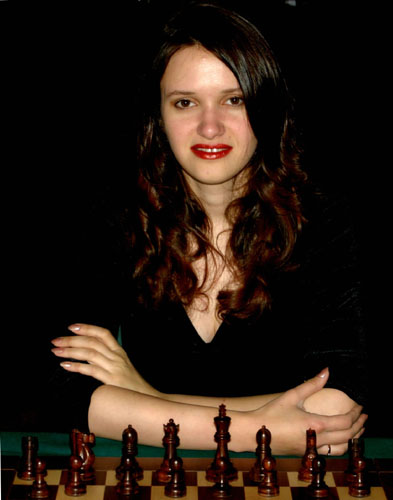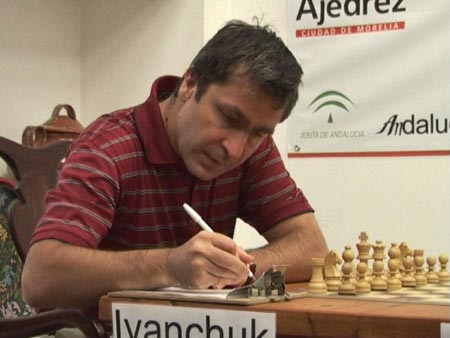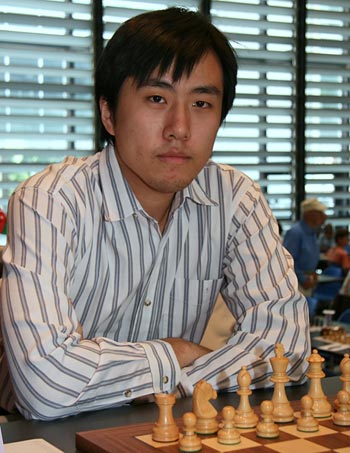| Latest | Greatest | Lobby | Journals | Search | Options | Help | Login |
|
|
|
This topic is archived. |
| Home » Discuss » Topic Forums » Sports |
|
| Jack Rabbit
|
Sun May-25-08 01:20 PM Original message |
| The Jack Rabbit Chess Report (May 25); Shulman, Zatonskih win US Championships |
|
Shulman and Zatonskih win US Championships
 Grandmaster Yury Shulman of Chicago by way of Minsk, and IM Anna Zatonskih of Long Island by way of Ukraine, become he new US chess chammpions on Wednesday in Tulsa, Oklahoma, at the conclusion of the championships tournaments. Ms. Zatonskih was the US women's champion once before, in 2006. She and defending champion Irina Krush, also originally from Ukraine, tied for first with 7� points in 9 rounds and had to play a series of blitz gamea to determine the winner. After splitting the first four playoff games, the championship came down to a single Armageddon game in which White has as extra minute and Black has the odds of draw. Ms. Krush lost the game on time when Ms. Zatonskih had only one second left herself. Ms. Zatonskih entered the final round trailing Ms. Krush by a half point. Ms. Zatonskih won her final game with Black against Tsagaan Battsetseg, who was born in Mongolia, while Ms. Krush played a marathon 104-move game against native Armenian Kat Rohonyan. The day before, Ms. Zatonskuh and Ms. Krush played each other in the eighth round to a draw in a magnificent struggle. Mr. Shulman is the US national champion for the first time. He succeeds Latvian-born Alex Shabalov, who succeeded Ukrainian-American Alex Onischuk, who succeeded Japanese native Hikaru Nakamura. California IM Josh Friedel scored 5� points to earn his third grandmaster norm. Mr. Friedel is an oddity among top-ranked American chess players. He was born in the United States. Armenian native Tatev Abrahamyan, who finished tied for third with Ms. Rohonyan in the women's competition, won the Fighting Chess Award sponsored by website Goddess Chess. Calendar Other events completed: The Capablanca Memorial Tournament was won by Cuban grandmaster Lenier Dom�nguez in Havana with 6 points out of nine. The President's Cup Open Tournamant was won by Russian grandmaster Evgeny Najer in the Azerbaijani capital of Baku with 7� points. Grandmaster and former women's world champion Antoaneta Stefanova of Bulgaria won the prize for best performance by a woman with 6� points. This week: The annual tournament sponsored by the Bosna Chess Club began in Sarajevo Friday. After three rounds, Alexander Morozevich of Russia leads with 2� points, followed by Cuban grandmaster Lenier Dom�nguez with 2. The Chicago Open, another major US event, began Friday featuring some of the same players who competed in the US Championships which finished only two days before in Tulsa. After two rounds, six players have perfect scores. The King's Tournament in Banza, Romania, an old-timers event, began yesterday. Lajos Portisch leads after two rounds with a point and a half. |
| Printer Friendly | Permalink | | Top |
| Jack Rabbit
|
Sun May-25-08 01:22 PM Response to Original message |
| 1. This week's games: |
|
Diagrams on the Jack Rabbit Chess Report are made with Chess M�rida, a true type font that can be downlaoded free here. !""""""""# $tMvWlVmT% $OoOoOoOo% $ + + + +% $+ + + + % $ + + + +% $+ + + + % $pPpPpPpP% $RnBqKbNr% /(((((((() WHITE White to move (This position is a theoretical draw) |
| Printer Friendly | Permalink | | Top |
| Jack Rabbit
|
Sun May-25-08 01:23 PM Response to Reply #1 |
| 2. Shulman - Kudrin, Round 6, Tulsa |
|
With this victory, Mr. Shulman took possession of first place and never looked back.
 US National Champion Yury Shulman Yury Shulman - Sergey Kudrin US Championships (General Competition), Round 6 Tulsa, 18 May 2008 West Inida Game: Indian Queen's Gambit (Exchange Opening) (Gr�nfeld Defense) 1.d4 Nf6 2.c4 g6 3.Nc3 d5 4.cxd5 Nxd5 5.e4 Nxc3 6.bxc3 Bg7 7.Nf3 c5 8.Rb1
8...0-0 9.Be2 b6
10.0-0 Bb7 11.Qd3 e6
12.Bg5 Qc7
13.Qe3 Nd7 14.Rfd1!?
14...Nf6
15.Nd2
15...cxd4 16.cxd4 Rac8 17.h3
17...Qc2 18.Bd3 Qa4
19.Bb5 Qc2 20.Re1 Qc3 21.Bd3
21...e5 22.d5 Nd7
23.Bb5
23...Qxe3 24.Rxe3
24...Bf6 25.h4
25...Bxg5
26.hxg5 Nc5 27.Nc4 h6
!""""""""# $ +t+ Tl+% $Ov+ +o+ % $ O + +oO% $+bMpO P % $ +n+p+ +% $+ + R + % $p+ + Pp+% $+r+ + K % /(((((((() WHITE: Yury Shulman Position after 27...h7h6 28.Nxe5!
28...hxg5 29.f3 Kg7 30.Ra3 Ra8
31.Bc6 Rfb8 32.Rc3
32...f6 33.Bxb7
33...Rxb7
34.Rxc5 fxe5 35.Rc6 Re8 36.Kf2 g4 !""""""""# $ + +t+ +% $Ot+ + L % $ Or+ +o+% $+ +pO + % $ + +p+o+% $+ + +p+ % $p+ + Kp+% $+r+ + + % /(((((((() WHITE: Yury Shulman Position after 36...g5g4 37.Rbc1!
37...gxf3 38.gxf3 Rf7 39.Rc7 Ref8 40.Ke3 Kh6
!""""""""# $ + + T +% $O R +t+ % $ O + +oL% $+ +pO + % $ + +p+ +% $+ + Kp+ % $p+ + + +% $+ R + + % /(((((((() WHITE: Yury Shulman Position after 40...Kg7h6 41.Rxf7!!
41...Rxf7 42.Rc6 b5 43.Re6 a5 44.Rxe5 b4 45.Re6 Rb7
46.Ra6 b3 47.axb3 Rxb3+ 48.Kf4 Ra3
49.d6 Kg7 50.Ke5 Rxf3 51.d7 1-0
|
| Printer Friendly | Permalink | | Top |
| Jack Rabbit
|
Sun May-25-08 01:25 PM Response to Reply #1 |
| 3. Battsetseg - Zatonskih, Round 9, Tulsa |
 US Women's Champion Anna Zatonskih Tsagaan Battsetseg - Anna Zatonskih US Championships (Women's Competition), Round 9 Tulsa, 21 May 2008 Closed French Game: Winawer Defense 1.e4 e6 2.d4 d5 3.Nd2 Nf6 4.e5 Nfd7 5.Bd3 c5 6.c3 b6
7.Ndf3
7...Ba6 8.Ne2!?
8...Bxd3
9.Qxd3 Nc6 10.0-0 Be7 11.Bf4
11...c4
12.Qd2 h6 13.Ng3!?
13...Qc7 14.Rfb1 Na5?
!""""""""# $t+ +l+ T% $O WmVoO % $ O +o+ O% $M +oP + % $ +oP B +% $+ P +nN % $pP Q PpP% $+ + + K % /(((((((() WHITE: Tsagaan Battsetseg Position after 14...Nc6a5 15.Nh5
15...Rg8 16.Qc1 0-0-0!?
17.b3 Kb7 18.Nd2 Rc8 19.a4 Ka8 20.Qf1?!
20...Nb8 21.b4 Nac6
22.Nxc4?
22...dxc4 23.Qxc4 Bg5?!
24.a5?
!""""""""# $lMt+ +t+% $O W +oO % $ Om+o+ O% $P + P Vn% $ PqP B +% $+ P + + % $ + + PpP% $Rr+ + K % /(((((((() WHITE: Tsagaan Battsetseg Position after 24.a4a5 24...bxa5!
25.b5 Ne7 26.Qxc7 Rxc7 27.Rxa5 Rxc3
28.Rba1 a6 29.bxa6 Rgc8 30.h4
30...Bxf4 31.Nxf4 Rc1+ 32.Kh2
32...Rxa1 33.Rxa1 Rd8 34.Ne2 Nf5
35.g3 Nxd4 36.Nc3
36...Ka7 0-1
|
| Printer Friendly | Permalink | | Top |
| Jack Rabbit
|
Sun May-25-08 01:27 PM Response to Reply #1 |
| 4. Zatonskih - Krush, Round 8, Tulsa |
 Irina Krush Zatonskih,Anna - Irina Krush US Chess Championships (Women's Competition), Round 8 Tulsa, 20 May 2008 West India Game: King's Indian Defense (Fianchetto Opening/Kavalek Variation) 1.d4 Nf6 2.c4 g6 3.Nf3 Bg7 4.g3 0-0 5.Bg2 d6 6.0-0 c6
7.Nc3 Qa5
8.e4 e5
9.h3 Nbd7 10.Re1 Re8
11.a3
11...Qc7!?
12.Be3
12...exd4 13.Nxd4 Nc5 14.Qc2 a5 15.b3 h5
16.Rad1 Nfd7 17.Rd2 Ne5 18.Red1 a4
19.b4 Nxc4 20.bxc5 Nxe3
21.fxe3 dxc5 22.Nde2 b5
23.e5?
23...Bf5
24.Qc1 Bxe5?
!""""""""# $t+ +t+l+% $+ W +o+ % $ +o+ +o+% $+oO Vv+o% $o+ + + +% $P N P Pp% $ + Rn+b+% $+ Qr+ K % /(((((((() WHITE: Anna Zatonskih Position after 24...Bg7e5:p 25.Ne4!
25...c4
26.Nd6 Bxd6 27.Rxd6 Be4
28.Qd2 Bxg2 29.Kxg2 Qe7
30.Kf2 h4 31.Qd4 c5?!
32.Qxc5 Rac8 33.Qd4 c3?
34.Nxc3 hxg3+
35.Kg2
35...Qxe3 36.Qxe3?
36...Rxe3 37.Nxb5 !""""""""# $ +t+ +l+% $+ + +o+ % $ + R +o+% $+n+ + + % $o+ + + +% $P + T Op% $ + + +k+% $+ +r+ + % /(((((((() WHITE: Anna Zatonskih Position after 37.Nc3b5:p 37...Rb3!
38.Rd8+ Rxd8 39.Rxd8+ Kg7 40.Nd4 Rxa3
41.Nf3
41...Ra1!
42.Kxg3 a3 43.Ra8 a2 44.Kf2
44...g5!?
45.Ne1!
45...Kg6 46.Nc2 Rh1 47.Kg2 !""""""""# $r+ + + +% $+ + +o+ % $ + + +l+% $+ + + O % $ + + + +% $+ + + +p% $o+n+ +k+% $+ + + +t% /(((((((() WHITE: Anna Zatonskih Position after 47.Kf2g2 47...Rd1!!
48.Rxa2 Rd2+ 49.Kf3 Kh5
50.Ke3 Rh2 51.Kd3
51...f5 52.Ra8 Rxh3+ 53.Ne3 g4
54.Rf8 Rf3 55.Ke2 Kg5 56.Rf7 Kg6 57.Ra7 Kg5 58.Ra5 Rf4
59.Ra8 Rf3 60.Rf8 Kg6 61.Rb8 Kg5 62.Rb5 Rf4 63.Rb8 �-�
|
| Printer Friendly | Permalink | | Top |
| Jack Rabbit
|
Sun May-25-08 01:29 PM Response to Reply #1 |
| 5. Cheparinov - Ivanchuk, Round 10, Sofia |
|
Edited on Sun May-25-08 01:33 PM by Jack Rabbit
 Vassily Ivanchuk Ivan Cheparinov - Vassily Ivanchuk MTel Masters Round 10 Sofia, 18 May 2008 Open Sicilian Game: Taimanov Defense 1.e4 c5 2.Nf3 Nc6 3.d4 cxd4 4.Nxd4 e6 5.Nc3
5...Qc7 6.Be3 a6 7.Qd2 Nf6 8.0-0-0 Bb4 9.f3 Ne5
10.Nb3 b5 11.Bd4
11...Be7 12.Qf2
12...d6 13.g4
13...0-0 14.g5 Nfd7 15.Rg1 Bb7
16.Kb1 Rfc8 17.Rg3!?
17...b4 18.Na4 Bd8 19.Nc1
19...Bc6!
20.b3 Bxa4 21.bxa4 Nc6
22.Be3 !""""""""# $t+tV +l+% $+ Wn+oOo% $o+nOo+ +% $+ + + P % $pO +p+ +% $+ + BpR % $p+p+ Q P% $+kNr+b+ % /(((((((() WHITE: Ivan Cheparinov Position after 22.Bd4e3 22...Qb8!
23.Rh3
23...Nb6 24.Qh4 h6 25.Qg3
25...Nxa4 26.Rxd6
26...hxg5
27.Bd3 Bf6 28.e5 Bxe5 29.Rh8+
29...Kxh8 30.Qh3+ Kg8 31.Qh7+ Kf8 32.Rd7 !""""""""# $tWt+ L +% $+ +r+oOq% $o+m+o+ +% $+ + V O % $mO + + +% $+ +bBp+ % $p+p+ + P% $+kN + + % /(((((((() WHITE: Ivan Cheparinov Position after 32.Rd6d7
32...Nc3+ 33.Ka1 Nb5+ 0-1
|
| Printer Friendly | Permalink | | Top |
| Jack Rabbit
|
Sun May-25-08 01:35 PM Response to Reply #1 |
| 6. Bu Xiangzhi - Topalov, Round 9, Sofia |
 Bu Xiangzhi Bu Xiangzhi - Veselin Topalov MTel Masters, Round 9 Sofia, 17 May 2008 Slav Queen's Gambit: Catalan Opening 1.Nf3 d5 2.d4 Nf6 3.c4 c6 4.Qc2 dxc4
5.Qxc4 Bf5 6.g3 Nbd7 7.Bg2 e6 8.0-0 Be7
9.Nc3 0-0 10.Re1
10...h6!?
11.e4
11...Bh7
12.Bf4 Rc8
13.Qe2 Re8
14.Rad1 b5 15.a3
15...a5 16.Ne5 Nxe5 17.Bxe5 Qb6 18.a4 Nd7
19.Bf4 b4 20.Nb1 Nf6
21.Be5
21...c5 22.Nd2 cxd4 23.Nb3
23...Qc6 !""""""""# $ +t+t+l+% $+ + VoOv% $ +w+oM o% $O + B + % $pO Op+ +% $+n+ + P % $ P +qPbP% $+ +rR k % /(((((((() WHITE: Bu Xiangzhi Position after 23...Qb6c6 24.Qb5!?
24...Qxb5 25.axb5 a4 26.Nxd4
26...Ng4
27.Bf4 g5
28.Bf3
28...Nxf2
29.Kxf2 gxf4 30.Nc6
30...fxg3+ 31.Kxg3 Bf8
32.Rd7 Bg6 33.e5 Bc5
34.Rc1 Be3 35.Rc4?!
35...a3 36.bxa3 bxa3 37.Ra4?
37...Bc5!
38.Ra6 a2?
!""""""""# $ +t+t+l+% $+ +r+o+ % $r+n+o+vO% $+pV P + % $ + + + +% $+ + +bK % $o+ + + P% $+ + + + % /(((((((() WHITE: Bu Xiangzhi Position after 38.a2a3 39.Rxa2!
39...Kg7 40.Ra6 Rb8
41.Nxb8 Rxb8 42.Bc6 h5 43.Ra8 Rb6
44.Rdd8 h4+ 45.Kf4 Bh7 46.Be4 Be7 47.Rdb8 1-0
|
| Printer Friendly | Permalink | | Top |
| Jack Rabbit
|
Sun May-25-08 01:50 PM Response to Reply #1 |
| 8. Aronian - Radjabov, Round 8, Sofia |
 Teimour Radjabov Levon Aronian - Teimour Radjabov MTel Masters, Round 8 Sofia, 16 May 2008 West India Game: King's Indian Defense (Gligoric Opening) 1.d4 Nf6 2.c4 g6 3.Nc3 Bg7 4.Nf3 0-0 5.e4 d6 6.Be2 e5 7.0-0
7...Nc6 8.d5
8...Ne7 9.b4
9...Nh5
10.Re1 a5
11.bxa5 Rxa5 12.Nd2
12...Nf4 13.Bf1 c5 14.a4 Ra6 15.Ra3 Nh5
16.Nb5 Nf6 17.Bb2!?
17...Ne8
18.Nf3
18...h6!?
19.g3!?
19...f5 20.exf5 Nxf5 21.Nd2
21...Nf6 22.Bd3
22...Rf7 23.Bc2 Bd7
24.Qb1
24...Rf8 25.Rf3
25...h5 !""""""""# $ + W Tl+% $+o+v+ V % $t+ O +o+% $+nOpOm+o% $p+p+ + +% $+ + +rP % $ BbN P P% $+q+ R + % /(((((((() WHITE: Levon Aronian Position after 25...h6h5
26.Ne4
26...Nxe4 27.Rxe4 Ra8
28.Re1
28...Rc8?!
29.Bc1
29...Ra8
30.Bd2 b6 31.Be3
31...e4!?
32.Rf4 Nxe3 33.fxe3
33...Bh6
34.Nxd6
34...Bxf4 35.gxf4 Qh4 36.Re2?!
!""""""""# $t+ + Tl+% $+ +v+ + % $ O N +o+% $+ Op+ +o% $p+p+oP W% $+ + P + % $ +b+r+ P% $+q+ + K % /(((((((() WHITE: Levon Aronian Position after 36.Re1e2 36...Bg4!!
37.Rg2 g5 38.f5?
38...Bxf5
39.Rg3 Bh3 40.Bxe4
40...Rf1+ 41.Qxf1 Bxf1 42.Bf5 g4
43.Be6+ Kh7 44.Bf5+ Kh8 0-1
|
| Printer Friendly | Permalink | | Top |
| Jack Rabbit
|
Sun May-25-08 01:36 PM Response to Original message |
| 7. Ask me anything. |
|
Edited on Sun May-25-08 01:52 PM by Jack Rabbit
I'll try to answer.
|
| Printer Friendly | Permalink | | Top |
| Jack Rabbit
|
Sun May-25-08 10:59 PM Response to Original message |
| 9. News Update |
|
From ChessBase.com
Dated Monday, May 26 Death of a chess original � Bukhuti Gurgenizde, 1933�2008 Bukhuti Ivanovich Gurgenizde was one of the most original and striking players of the Soviet era. He won the Championship of his native Georgia eleven (or twelve) times, competed in nine USSR Championship finals, and was the trainer of some of the most successful women players in the game. His name has been applied to variations in the Modern Defence and the Sicilian. In Memoriam. Read more. |
| Printer Friendly | Permalink | | Top |
| DU
AdBot (1000+ posts) |
Tue Apr 16th 2024, 02:10 AM Response to Original message |
| Advertisements [?] |
| Top |
| Home » Discuss » Topic Forums » Sports |
|
Powered by DCForum+ Version 1.1 Copyright 1997-2002 DCScripts.com
Software has been extensively modified by the DU administrators
Important Notices: By participating on this discussion board, visitors agree to abide by the rules outlined on our Rules page. Messages posted on the Democratic Underground Discussion Forums are the opinions of the individuals who post them, and do not necessarily represent the opinions of Democratic Underground, LLC.
Home | Discussion Forums | Journals | Store | Donate
About DU | Contact Us | Privacy Policy
Got a message for Democratic Underground? Click here to send us a message.
© 2001 - 2011 Democratic Underground, LLC